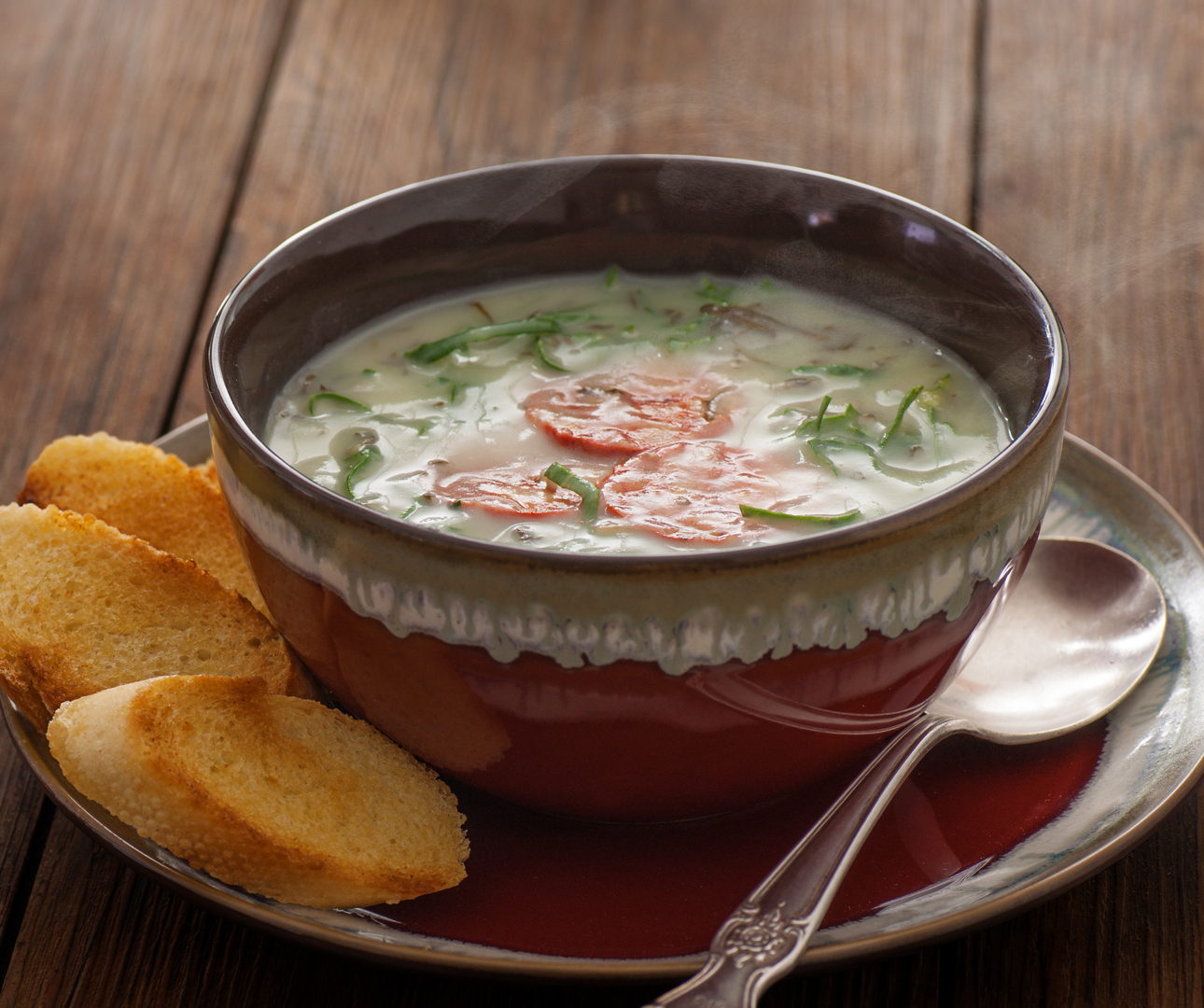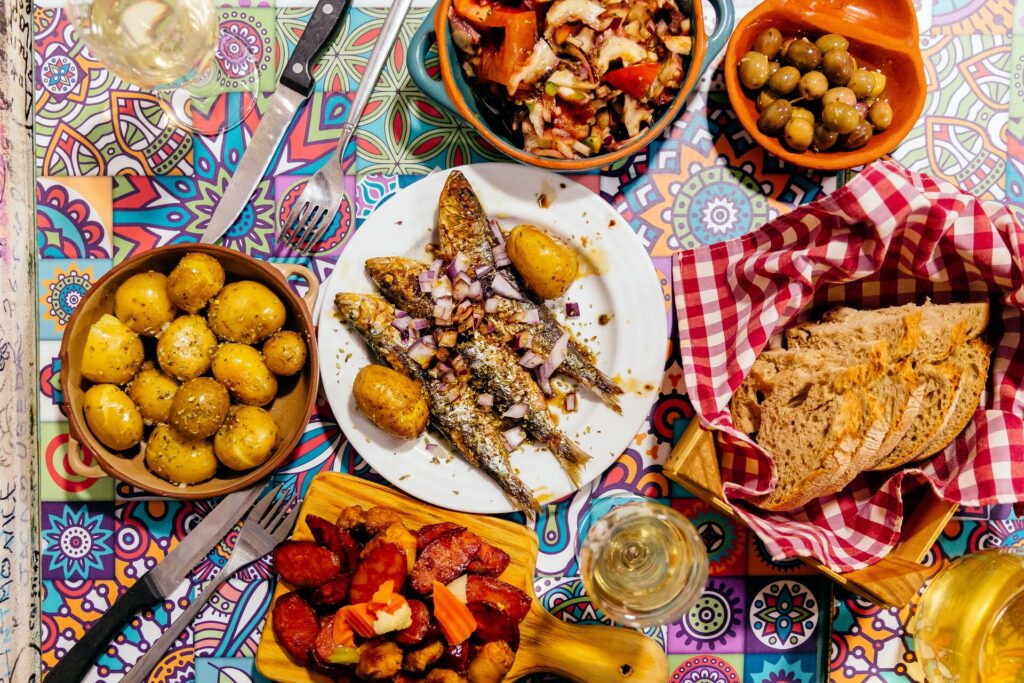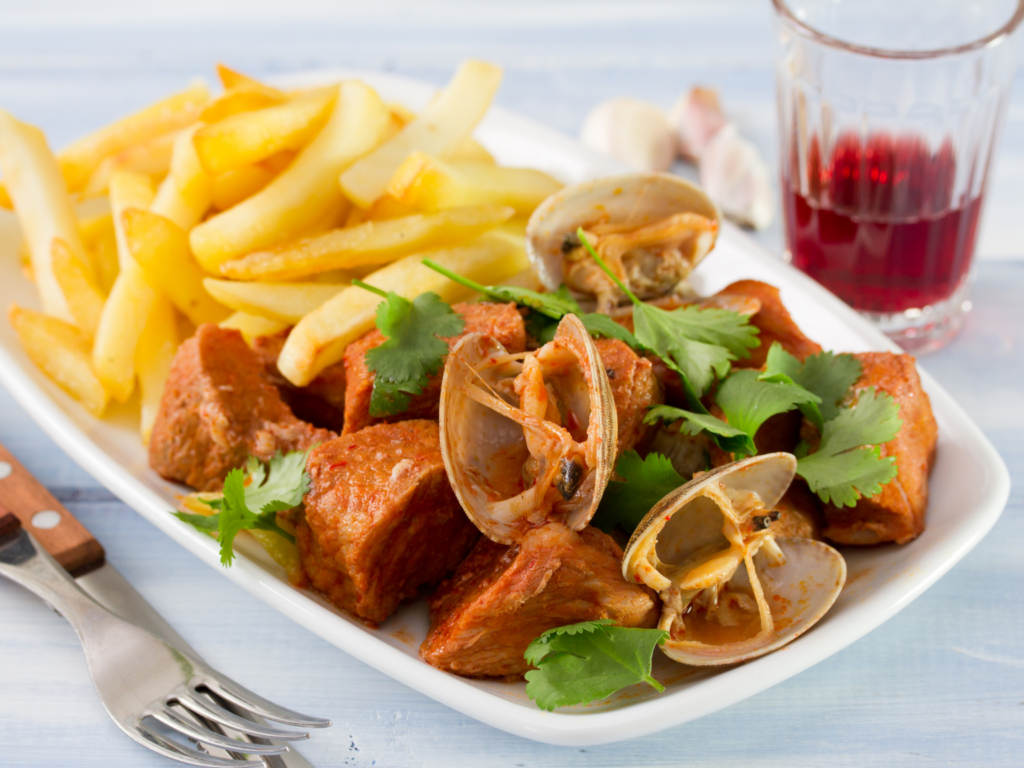Experience an Authentic Taste of Portugal's History in Tomar
15 Must-Have Traditional Portuguese Foods to Try on Your Next Trip
Portuguese food is all about local ingredients and big, powerful flavors. Whether you plump for the salty punch of bacalhau, the sweet custardy kick of pastel de nata, or the pungent combination of paprika, garlic and bay leaves that forms the basis of many local recipes, traditional Portuguese dishes offer bold and beautiful flavors.
To guide you on your culinary explorations of what to eat in Portugal, here’s our pick of the top 15 foods to try on your next Portugal guided tour.
1. Pastel de Nata

Image Source: Insight Vacations
Pastel de Nata has a rich history dating back to the 18th century in Lisbon. It was created by Catholic monks at the Jerónimos Monastery, who used egg whites to starch their clothes and had leftover yolks. These yolks were then used to make the custard filling. These original pastries are called ‘Pastéis de Belém’, because the recipe was never shared and therefore they are patented under that name. Every other similar treat, found throughout Portugal, is a replica of this hidden recipe and therefore must be called ‘Pastéis de Nata’.
2. Peixe Grelhado
Peixe Grelhado, or grilled fish, is one of the most popular traditional Portuguese dishes, known for its simplicity and fresh flavors. Its history dates back to ancient times when fish was a staple food for coastal communities. This cooking method allows the natural flavors of the fish to shine through, resulting in a delicious and healthy meal.
Drizzled in olive oil, sprinkled with chunks of salt and grilled over charcoal until the skin turns crispy, Peixe Grelhado is the bass note of every Portuguese menu, and for good reason. Applied to almost every fish, this marinade can most often be found on red snapper, sardines, bass, bream and mackerel. Grilled over an open flame, the dish is often served with a side of vegetables or a salad.
3. Alheira de Mirandela
Alheira may look like a sausage, but it’s so much more. In fact Alheira de Mirandela is a unique Portuguese sausage with a fascinating history. Originating in the Jewish community of Mirandela during the Inquisition, it was created as a way for Jews to disguise their identity and avoid persecution. The sausage was made to resemble chorizo, but instead of pork, it was filled with a mixture of bread, poultry, and game meats. This allowed Jews to appear to be eating pork, a forbidden food, while actually adhering to their dietary laws.
The sausage is traditionally smoked over oak wood, giving it a distinct flavor. It is typically served grilled or roasted, often accompanied by potatoes or vegetables, or enjoyed with a fried egg and served with French fries.
4. Bacalhau
Bacalhau is simply salted, dried cod, but this humble ingredient features in over a thousand Portuguese recipes. Whether roasted à Lagareiro, cooked in a casserole bacalhau à brás or simply stuffed in bar snacks like croquettes, the salt cod has an intense flavor that is is dangerously addictive.
This traditional Portuguese dish became popular during the Age of Discovery in the 15th and 16th centuries when Portuguese sailors needed a way to preserve fish for long voyages and salt cod proved to be an ideal solution.
The fish was caught in the cold waters of the North Atlantic, particularly off the coast of Norway, and then salted and dried on board the ships. This allowed the fish to be stored for months without spoiling, making it a valuable source of sustenance for the sailors. There are several interpretations of the bacalhau, most famously as little fried balls called ‘Bolinhos de bacalhau’.
5. Bifana
A decadent sandwich if ever there was one, bifana contains thinly sliced pork marinated in a garlic and white wine mixture, fried in a lardy sauce and then slapped between the folds of a Portuguese roll.
This traditional sandwich is a popular street food in Portugal, enjoyed by locals and often garnished with mustard and served with French fires and a side of pickles.
6. Caldo Verde

Caldo Verde © iStock/TheCrimsonMonkey
A much-loved local dish, Caldo Verde might seem like cabbage soup to the uninitiated. Deceptively difficult to prepare, it has its greens cut up in very particular ways, absorbing much of the faint smoky flavor imparted by the addition of barbequed Portuguese sausage.
This traditional Portuguese soup is made with potatoes, kale, onions, garlic and chorizo or linguica sausage. It’s a popular dish during the colder months, often served as a starter or main course.
The dish dates back to the 16th century when Portuguese explorers brought potatoes and kale from the New World to Europe. The soup was originally made with cabbage, but kale became the preferred green due to its availability and nutritional value.
7. Carne de Porco Alentejana
Portugal’s version of surf and turf involves great mounds of pork and clams. Tumbled in a mixture of paprika, garlic, bay leaf and coriander, when the clams are added to the mix they open up, letting their divine salty juices trickle onto the pork.
The dish is typically made with pork loin or shoulder and is served at family gatherings and celebrations. Originating in the Alentejo region of Portugal, Carne de Porco Alentejana was introduced by the Moors during their occupation of the Iberian Peninsula. its renowned as comforting and satisfying dish that showcases the flavors of the region.
Save up to $3,000* per couple on your first Premium Tour
Plus receive latest offers, travel inspiration, and discover how your travels will make a positive impact. Together, WE MAKE TRAVEL MATTER®. Subscribe Now8. Ovas
Portugal is a country with a longstanding love of seafood, and as such there are a variety of local recipes that make use of the entire fish – even the egg sacs! This popular local salad takes the egg sacs and tosses them with onion, bell peppers, tomatoes and lettuce. It’s much tastier than it sounds, we promise.
Ovas, also known as fish roe, are a delicacy in Portuguese cuisine, particularly in the Algarve region. They are the eggs of various fish species, including hake, mullet and tuna.
In the Algarve, ovas are typically harvested from mullet, which are abundant in the region’s coastal waters. The roe is carefully removed from the fish and cleaned, then salted and cured to preserve it. The resulting product is a rich, flavorful delicacy that is often enjoyed as a topping for bread or crackers, or as an ingredient in salads and other dishes.

Image source: Canva
9. Sardinhas assadas
Despite lots of delicious fish varieties giving sardines a run for their money, it’s the little nibbler that remains the most beloved. Affordable and delicious, they form the perfect accompaniment to jugs of sangria or served up with lots of vegetables.
A traditional and beloved dish in Portuguese cuisine, particularly during the summer months when they are in season, these small, oily fish are abundant in the coastal waters and have been a staple of the country’s diet for centuries.
Sardinhas assadas are grilled sardines, typically cooked over an open flame, which imparts a smoky flavor to the fish and crisps the skin. They are a popular street food and are often served with a simple seasoning of salt and olive oil, which enhances their natural flavor.
10. Salame de chocolate
Also found in Italy, this ubiquitous chocolate “salami” can be bought in most food shops and pastelarias across Portugal. A moreish mixture of dark chocolate, nuts and broken up cookies, this sweet treat rivals even the great Pastel de Nata.
The mixture is shaped into a log, rolled in powdered sugar, and chilled until firm. When sliced, the dessert resembles a salami, with the crushed biscuits and nuts or fruit resembling the meat and fat in a traditional salami.
11. Arroz de Pato

Image source: Canva
Arroz de Pato, or duck rice, is one of Portugal’s most indulgent comfort foods, combining shredded duck meat with savory rice, chouriço slices, and a golden baked crust. Traditionally cooked in a clay pot, the dish gets its rich flavor from being simmered in the broth used to poach the duck, which infuses every grain of rice with a deep meaty essence. A layer of crispy chouriço on top adds both texture and a smoky depth that complements the succulent duck meat beneath.
Originating from the north of Portugal, particularly the city of Braga, Arroz de Pato is often served at family gatherings and special occasions. Its elaborate preparation makes it a celebratory dish, one that’s steeped in culinary pride. The contrast between the juicy duck and the crispy topping gives each bite a delightful mix of soft and crunchy, rich and savory.
12. Amêijoas à Bulhão Pato
This classic Portuguese dish, ‘Bulhão Pato clams’, is filled with garlic, olive oil, white wine, and cilantro: a seafood lover’s dream. Amêijoas à Bulhão Pato takes its name from the 19th-century Portuguese poet Raimundo António de Bulhão Pato, a known gastronome and lover of local cuisine. Despite its literary namesake, this dish is unfussy, rustic, and all about letting fresh clams shine through simple but bold flavors. The generous use of garlic and olive oil, paired with the bright pop of cilantro, creates a deeply aromatic and unforgettable sauce.
Often served with crusty bread to mop up the juices, this dish is a staple in seaside towns and Lisbon tascas (taverns) alike. It’s typically enjoyed as a starter or petisco (Portuguese tapas), and when paired with a chilled glass of vinho verde, it embodies the relaxed spirit of Portuguese coastal dining. The simplicity and freshness of Amêijoas à Bulhão Pato highlight how Portuguese cuisine finds elegance in the unpretentious.
13. Piri Piri Chicken
Piri Piri Chicken, or frango piri piri, is Portugal’s fiery contribution to the world of grilled chicken. Originally brought back from former African colonies like Mozambique and Angola, the piri piri chili (a small, spicy pepper) quickly became a key ingredient in Portuguese kitchens. The piri sauce marinade—typically made with crushed chilies, garlic, lemon, olive oil, and paprika—is slathered onto the chicken before it’s flame-grilled to perfection, creating a tantalizing combo of spice, smoke, and zest.
Served with fries, salad, or rice, this dish is a national favorite and can be found everywhere from roadside churrasqueira (grill houses) to high-end restaurants. The level of heat varies, but the hallmark is always that addictive, chargrilled skin and juicy meat. Piri Piri Chicken exemplifies Portugal’s culinary fusion with its colonial past and its love of bold, unforgettable flavors.

Image source: Canva
14. Leitão (Suckling Pig)
Leitão, or suckling pig, is a celebratory dish especially revered in the Bairrada region of central Portugal. Prepared from a young piglet, the meat is marinated in a mixture of garlic, bay leaves, lard, and white wine before being slowly roasted in a wood-fired oven. The result is succulent, tender meat encased in a golden, crispy skin that crackles with each bite. It’s a feast dish, often associated with weddings, holidays, and grand gatherings.
What makes Leitão so special is the balance of textures and the infusion of flavor throughout the meat. Traditionally served with orange slices and a side of spicy sauce, it’s both rich and refreshing. Many food lovers travel to Mealhada, the “Capital of Leitão,” for the most authentic experience, where the dish is treated with almost sacred reverence.
15. Carne de Porco à Alentejana
This dish is one of the most iconic of Portuguese cuisine, combining pork and clams in a way that might seem surprising at first but works brilliantly. Originating in the Alentejo region, Carne de Porco à Alentejana features marinated pork cubes (often with a paprika and garlic rub) that are sautéed and mixed with clams, then garnished with coriander and served with fried potatoes or bread. It’s a striking example of Portugal’s land-meets-sea culinary style.
The dish’s blend of juicy pork and briny clams creates a rich umami flavor, while the addition of white wine and lemon helps to cut through the richness. While it’s now beloved nationwide, its name reflects its rustic, regional roots and the generous hospitality of Alentejo cuisine, which is known for hearty, comforting dishes that celebrate local produce and traditional methods.

Image source: Canva
The national dish of Portugal is bacalhau, or salted cod. Often referred to as the “faithful friend” (fiel amigo), bacalhau is so ingrained in Portuguese culinary culture that it’s said there are more than 365 ways to cook it—one for every day of the year. It can be baked, fried, grilled, or boiled, and appears in iconic recipes like bacalhau à brás (shredded with onions, eggs, and potatoes), bacalhau com natas (with cream), or bacalhau à lagareiro (roasted with garlic and olive oil). Despite its popularity, cod isn’t actually native to Portuguese waters—it’s imported, usually from Norway or Canada, then preserved in salt and rehydrated before cooking.
Bacalhau’s popularity dates back to the Age of Discoveries, when salted and dried cod became an ideal food source for long sea voyages due to its long shelf life. Over time, it became a staple at home too, especially during Catholic fasting periods when meat was off the table. Today, bacalhau is often served at festive occasions, especially Christmas Eve, and continues to hold a special place at the heart of Portuguese identity and tradition.
What do Portuguese have for dinner?
Dinner in Portugal tends to be a light yet satisfying affair, often served later in the evening, typically around 8 or 9 PM. Traditional Portuguese dinners may include a hot soup like caldo verde (potato and kale soup), followed by a main course featuring fish or meat. Grilled sardines, pork chops, or arroz de marisco (seafood rice) are common choices, often accompanied by rice, salad, or boiled potatoes. Simpler dinners might be a hearty sandwich or omelette, depending on the household or occasion.
Portuguese meals are rarely rushed, and dinner is no exception—it’s as much about sharing time with family as it is about the food itself. Wine or beer is commonly served, and many dinners end with a small espresso (bica) or a light dessert like fruit or salame de chocolate.
What is the main meal of the day in Portugal?
In Portugal, almoço (lunch) is considered the main meal of the day. It’s typically eaten between 12:30 and 2:00 PM and is often a substantial, sit-down affair, especially in traditional households or workplaces that still observe a longer midday break. A typical lunch may include soup to start, a hearty main dish of meat or fish, a side of rice or potatoes with vegetables, and sometimes a small dessert or fruit to finish. It’s not uncommon for lunch to be accompanied by bread, olives, and a glass of wine or juice.
Because dinner is eaten later and tends to be lighter, lunch is when most Portuguese people get their biggest serving of calories and nutrients. In rural areas and among older generations, lunch is also a social occasion that brings families together in the middle of the day. Even in busy urban settings, many workers step out to local tascas or cafés for a full prato do dia (dish of the day), showcasing the importance of lunch in Portuguese daily life.
LIKED THIS POST? SHARE WITH YOUR COMMUNITY





